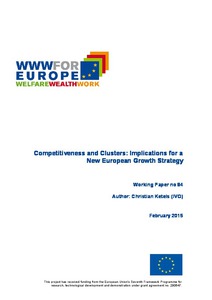Competitiveness and clusters: implications for a new European growth strategy
"This paper develops policy recommendations on the use of cluster-based economic policies and the adoption of a new concept of competitiveness in the context of the new growth path that WWWforEurope aims to outline. A first section discusses summarizes key findings from the previous research pa...
| Main Authors: | , |
|---|---|
| Institution: | ETUI-European Trade Union Institute |
| Format: | TEXT |
| Language: | English |
| Published: |
Vienna
2015
WWWforEurope |
| Subjects: | |
| Online Access: | https://www.labourline.org/KENTIKA-19114179124919323519-Competitiveness-and-clusters-i.htm |
| Summary: | "This paper develops policy recommendations on the use of cluster-based economic policies and the adoption of a new concept of competitiveness in the context of the new growth path that WWWforEurope aims to outline. A first section discusses summarizes key findings from the previous research papers on the role of clusters in the New Growth Path (MS47) and on a new concept of competitiveness that embeds beyond-GDP objectives (MS46). It then extends this work by deriving an initial set of policy implications from this research. For clusters, these implications address both general practices of cluster-based economic development and specific issues related to the use of cluster-based concepts in a transition to a New Growth path. For competitiveness, it specifically discusses the new concept of competitiveness proposed in MS46 and the notion of trade-offs among different dimensions of performance in this new concept. The second section of the paper explores the ways in which beyond-GDP objectives have been integrated into the current practice of cluster-based economic development efforts across Europe. It is based on interviews with policy makers and cluster initiatives as well as the review of relevant policy documents. For cluster programmes, i.e. the policy actions implemented by government, the paper organizes the existing efforts into three categories, differentiated by the extent to which beyond-GDP categories drive the activities supported. For cluster initiatives, i.e. the collaborative efforts by private-public groups focused on enhancing the competitiveness of a specific regional cluster, the existence of a market and the need for systemic changes are identified as key factors that drive the adoptation of beyond-GDP objectives. There is also a discussion of the relevant scope of the activities in beyond-GDP related efforts relative to existing cluster categories. The third section analysis the Europe 2020 Strategy, including its objectives, quantiative performance indicators, and the European Semester as a policy review process, from the perspective of the new definition of competitiveness proposed in MS46. After exploring whether the objectives of the strategy and the new definition of competitiveness are compatible it looks at their ability to drive an effective and transparent policy process towards policies consistend with a New Growth Path. The final section then develops five policy conclusions from the prior analysis. Three are focused on the use of cluster-based economic development tools as instruments to achieve beyond-GDP objectives. The recommendations deal both with the way cluster-based tools can be used and with how they should be structured. Two of the conclusions are focused on the Europe 2020 strategy process. They deal with the need for a shared, explicit definition of competitiveness, proposing the definition developed in MS46 as a candidate. And they deal with creating a more transparent policy process that more clearly separates political decisions from analytical evaluations." |
|---|---|
| Physical Description: | 42 p. Digital |

